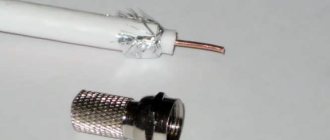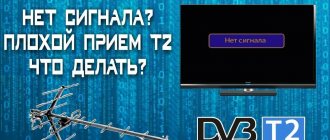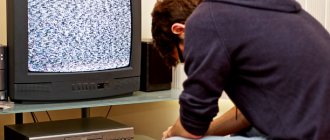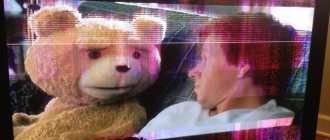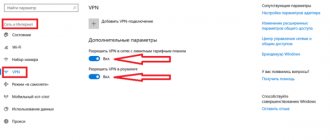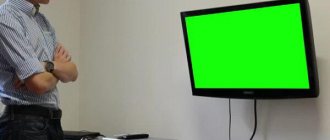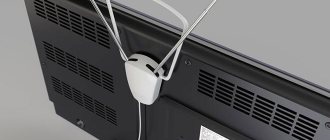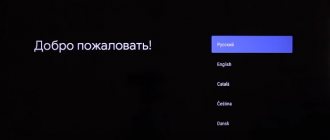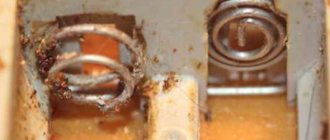Is there interference on the TV screen and the picture is scattered? Does digital TV show poorly? What to do?
There may be several reasons why digital television does not show today, from simple and easy to fix to more complex:
- The wave channel antenna is not precisely aligned towards the repeater;
- High-quality reproduction of digital channels is hampered by induced interference from wires on power lines and nearby transmitters for various purposes - from military to cellular towers;
- Poor contact. In the antenna connector of the TV, the cable is poorly soldered to the antenna or the integrity of the RF cable braid is damaged;
- The distance to the repeater is too large, not corresponding to the height and power of your antenna;
- Terrain with large elevation differences and dense forest on the radio route to the television transmitter;
How the problem manifests itself
Freezing interferes with viewing and can manifest itself as follows:
- the picture falls apart. Squares of the wrong color appear on the screen, the contours of figures bifurcate, when changing frames, a piece of the picture may remain from the previous scene;
- The sound disappears when the image is working;
- A black screen appears when the audio signal is normal;
- there is no sound, no picture. Sometimes a message appears from the digital tuner: “No signal.”
Is the picture on your TV falling apart?
One specific channel, a group of them (multiplex) or the entire received range can be inhibited.
The freeze is due to the digital signal transmission technology itself. If you don’t go into depth, it is transmitted like this: information is divided into small portions and “shot” with electromagnetic pulses into the air or cable. The packets are encoded and protected, but for some reason they may be distorted during transmission so that they are either not reproduced at all, or the digital tuner interprets them unsuccessfully.
Smart TV software update
If you are the owner of an LG, Sony, Samsung or other popular brand marked Smart TV, the reason may lie in a software update that occurred automatically, but for some reason destroyed the channel settings.
It is possible that the update may not have installed or another error may have occurred, therefore:
- Turn off the TV and unplug it - this is very important. You need to completely unplug the device from the outlet and wait about 20-30 minutes. This instruction manual is available on almost all official websites of TV manufacturers.
- Turn on your device. Let the TV connect to the Internet.
- Use your remote control to open Settings.
- In the “Support” section, select “Software Update” and update the firmware to the latest version.
- Then go to the “Broadcast” section and check the operation of the channels. If the screen shows a black square, go to the channel selection and automatically find them again.
Possible causes and their elimination
External factors
The most likely explanation for a TV with a digital set-top box freezing is the effect of external factors.
These include:
- weather. The earth's atmosphere is transparent to satellite signals. However, during heavy clouds and thunderstorms, signals from satellites may be distorted. The same applies to terrestrial TV transmitted from a repeater;
- technical problems on the transmitting side;
- scheduled maintenance work at the station - manifests itself as a complete disappearance of the signal.
How to check external factors
Diagnosis of external causes is carried out as follows:
- if the malfunction is caused by a breakdown of the repeater or a failure at the transmitting station, it makes sense to ask neighbors who use the same type of television if they have problems;
- click on the channels. If some are caught well and others are not, then the problems are definitely external. But at the same time, the channels must be of the same type;
- wait for the weather to change. If reception improves, then rain or cloudiness is to blame.
What to do if external problems are detected?
- If the weather interferes with television reception, you should more accurately adjust the antenna to the repeater or satellite. This will help achieve a slight increase in the received signal power.
- If the settings do not have an effect, you should consider purchasing a signal amplifier or a more sensitive digital tuner.
- If there is still no effect, you should think about changing the operator (for example, switch to cable TV or buy a satellite dish with a decoder).
In general, external problems are among the most common and difficult to solve: it is impossible to change the weather or repair transmission equipment yourself.
- HQClear TV antenna for T2 television: scam or Japanese technology?
Hardware problems
Also, the reason why the image freezes on a particular TV may be a malfunction or poor configuration of the user’s equipment.
Here the problems can be of the following types:
- with antenna;
- with coaxial cable;
- with attachment;
- with connection to TV;
- with TV receiver.
The most common antenna problems:
- Wrong type. To receive digital TV, you need one that operates in the UHF range, and not in the HF range, as for analogue broadcasting.
- Incorrect orientation. Almost all UHF television antennas are very sensitive to direction. The pins or loops of the resonators must be across the wave, and the central rod, accordingly, is very precisely aimed at the repeater. If we are talking about a satellite parabolic antenna, then ideally its axis should point clearly at a specific satellite with a deviation of no more than a degree.
- The antenna is obscured by an obstacle. Hills, permanent buildings, iron roofs - all this interferes with signal reception.
Antenna cable problems:
- The resistance is too high and, as a result, the signal attenuates.
- Parasitic interference. In this case, the cable begins to act as an additional antenna that receives the wrong channel, and as a result, chaos reigns in the output signal.
- The cable is broken or its contact with the antenna is broken.
- The plug is broken and the connection to the decoder or TV is poor (if the built-in tuner is used).
Problems with the console:
- The channel settings are lost. This often happens during an emergency shutdown (for example, if the set-top box was deprived of power not normally, but simply by cutting off the electricity;
- Software is outdated. This applies more to satellite receivers;
- The attachment is out of order.
Problems with the cable connecting the external tuner and the TV:
- the wire is too long and, as a result, has excessive resistance;
- The cable is not connected correctly (for example, the plug carrying the audio is not plugged in).
TV problems:
- settings are lost;
- a breakdown occurred.
How to check all hardware problems
Since there are many types of equipment failures, there is no single solution. But there are a number of steps that will help you figure out why the freeze appeared and fix it.
Attention: some steps require skills and additional equipment.
So what should you do?
- The best TV antennas for a summer residence with an amplifier for 2021
- Change the direction of the antenna, accurately aligning it with the satellite or repeater. You can find out the exact bearing for a given point using the CETV map.
- Check the antenna type and replace it if necessary.
- If an obstacle interferes with reception, move the antenna to another location, raising it as high as possible. You can understand that this is exactly the case simply by looking in the direction where the antenna is facing: UHF waves propagate in the line of sight zone.
- If the problem is that the signal is too weak, connect an amplifier. You can check the reception level using a tuner (in most modern devices, scales of signal strength and quality are available in the settings) or with a multimeter.
- If the problem is the cable resistance, it should be replaced with another brand with a copper core and a maximum shielding factor. The situation with parasitic interference is also resolved.
- The integrity of the cable is determined by “ringing” it with a multimeter. If a break is detected, the entire wire is replaced.
- Loss of contact with the antenna or breakage of the plug is determined visually. In this case, you just need to replace the “plug”.
- The broadcast standard with which the set-top box works can be checked with the seller or on the manufacturer’s website. If the equipment is not compatible with DVB, it needs to be changed.
- Outdated software for satellite TV can be updated by leaving the receiver turned on on the service channel or using another method recommended by the provider company. We also recommend that you reflash it by downloading the update from the official website and following the instructions there.
- Checking the connection of the set-top box to the TV. If there are several outputs (for example, through “>Euro-AV and “>RCA”), you can try another option.
- Lost tuner settings can be corrected by searching for channels again in automatic or manual mode.
- If the problem is equipment failure, you should contact a repair shop. The average user will not be able to repair a TV or set-top box.
If nothing helps, you need to call a specialist and resolve the issue with him.
Technical damage
A common reason that there is no signal on the TV is the presence of hardware failures in the equipment connected to the TV. The most common:
- Mechanical damage to the television cable: break, damage to insulation, etc.
- Damage or deformation of the satellite dish/antenna: weather, vandalism or physical aging.
- Problems with the receiver: connector, board, firmware.
Based on the information received, it is necessary to visually examine each component and determine where the technical damage occurred.
Cable
First of all, check whether the cable plug is properly secured in the connector of the TV or set-top box. There is a possibility that weak fixation by the socket is the cause of a weak signal or its complete absence.
If the problem is in the connector, you should firmly secure the cable in it. And if this is not possible due to deformation of the connector or cable, you should re-solder the connector, strip the cable and connect it correctly.
Examine the cable along its entire length to the antenna (to the cabinet with the provider’s equipment). Check the cable for breaks, cuts, exposed insulation and other signs of cable failure. If any are identified, it is recommended to replace the cable or “cure” it using an F-socket to F-socket adapter.
If you have access to an antenna, check the quality of the coaxial cable connection to the antenna. It is important that no damage to the connectors is observed.
Antenna
Take a close look at the antenna. Pay attention to:
- The direction in which the antenna is turned (especially if the nearest repeater is tens of kilometers away). If the wind changes the orientation, try to return it to the correct position. For a satellite dish, a correctly aligned converter is important. If it moves even a fraction, the signal may disappear.
- The condition of the antenna – it may be covered in dust, dirt, snow or covered with ice, or part of it is already rusty. If possible, clean the signal receiving devices, since all these factors negatively affect the signal quality.
- The condition of the brackets and other structures on which the antenna is placed. Perhaps they no longer provide the stable position that the antenna needs.
Receiver
When checking everything else, it still says that there is no digital television signal, check if your DVB-S or DVB-T/C set-top box is letting you down.
Frequent breakdowns of the digital assistant:
- Decoder failure.
- Oxidation or burnout of contacts.
- Power supply failure.
- Failure in the internal memory (hardware or software).
Sometimes, fixing a problem with your current receiver costs more than buying a new one. Re-soldering connectors or regular flashing can pay off if the memory module fails. The remaining damage usually does not pay off, and it is easier to buy a new console.
It is advisable to flash it with native firmware, which is available on television and radio resources on the Internet. You need to select native firmware according to the model of your receiver. If the device is still supported by the developer, flash the latest stable version of the software.
What other difficulties are there with setting up?
| Problem | Solution |
| No signal | Clean the antenna. Snow, dust, dirt often stick to it, and fallen leaves also stick to the parabolic antennas. |
| Poor picture and/or sound | Check that the TV receiver matches the signal quality. Even not very old TVs may not be able to play high-quality programs with multi-channel sound and HD images (plasma especially suffers from the latter). The problem can be solved by setting the receiver to a lower quality or replacing the TV. |
| Channels are not caught or only part of them is received | Check to see if there is any signal in this area. For terrestrial television, check this on the RTRS map. Perhaps there is no broadcast at the receiving point yet. |
| Previously received channels disappeared | Check the frequencies and TVCs on the RTRS map - they may have changed. If so, perform a manual search again. |
TV has actually become an essential element of a modern apartment. This device should not only fit harmoniously into the interior, but also create a high-quality image of the received transmission. Sometimes it happens that the TV shows poorly. The easiest way to solve this problem is to call a teleworker, but not everyone can afford it, and you have to wait for a specialist to arrive.
In most cases, the problem of poor image can be solved on your own with a minimal understanding of signal transmission processes. The following is a description of several simple procedures, the full or partial implementation of which allows you to achieve a high-quality image with a 90% probability.
All the actions described below do not require the use of measuring instruments and are based on two main actions:
- comparing existing wiring with a known good line.
- identifying an internal fault by visually inspecting the entire line from the antenna output to the television input.
After this, the appropriate repairs are carried out.
Not all channels broadcast
If all of the above has been checked and done, and the output of the TV with a satellite receiver and dish produces a weak signal, and in some places there is none at all, perform the initial setup of the receiver to receive a satellite signal:
- Open the menu, select the desired satellite and frequency.
- Information about specific channels can be taken from the “info” information. This data is also available on the Internet, in the public domain.
- Afterwards, select the correct port. Typically, this is a 4-port "DiSEqC".
- If colored stripes appear (signal quality), save the settings.
- Then, set up other satellites in the same way.
If your TV loses signals from the antenna from time to time, the tuner is to blame. More precisely, a decoder that needs to be reflashed. It is important to note that decoder firmware and tuner firmware are two different things. For this purpose, it is recommended to take the tuner to a service center or replace it with a new one.
TV channels are broadcast in several ways, including cable and digital terrestrial television. What is the difference between the two technologies? Which option should I choose? Is free digital data really beneficial?
Short circuit in plug connectors
The signal on the way from the antenna output to the TV can pass through several connectors: at the antenna output, at the installation sites of splitters, at the point of increasing the length using a coaxial feed-through adapter, Figure 1. If the cable part of the detachable connector is installed carelessly, the braided wiring may touch the central core, which immediately leads to a drop in signal level and unstable image reception.
Figure 1. Option for coaxial feed-through adapter
This malfunction is detected by visual inspection of all detachable connections in the path.
Cable jam
Another reason for a short circuit is a “kink” in the cable, as a result of which the central core pushes through the insulation and reaches the braid. It can appear either as a result of careless installation, or during operation as a result of excessively strong bending. The consequences of clamping a door, a chair, etc. are very similar.
- TOP-5. The best indoor antennas for digital television. Rating 2021!
Also revealed by inspection. The best way to repair a damaged cable is to replace it with a new one.
No contact in the plug
Another weak polymer wiring element is the Soviet-made plastic antenna plugs. It also ages, becomes brittle and breaks easily with little force, resulting in loss of contact.
In addition, even an apparently serviceable plug can lose contact with the cable along the core or braid if there is a strong pulling force on it.
In this situation, the old plug should be replaced with a new threaded F-connector, Figure 2. It is simply screwed onto the cable over the braid. The excess central wire is cut off with side cutters.
Figure 2. Threaded F-connector for coaxial cable
High fan-out ratio
To connect several TVs to one antenna, splitters are used, an example of which is shown in Figure 3. Each such device introduces certain losses into the transmission path, too much of which affects the image quality. If you can improve the reception quality by eliminating the splitter from the path and bringing the signal to the TV using the pass-through adapter mentioned above, then you should switch to an active splitter, Figure 4. It differs from its passive counterpart in the presence of a built-in amplifier, which helps solve the problem of low signal level.
Figure 3. Three-output antenna splitter Figure 4. 2-channel active antenna splitter
Good day!
They say that “the best is the enemy of the good...”, and perhaps this is correct. Analogue TV, in general, provided very good broadcast quality even in many remote corners of our country.
Having replaced it with digital (let me remind you that in June/July of this year our whole country begins to switch to it) - many are faced with the fact that the quality of the broadcast has noticeably dropped, and they cannot watch TV as before, because... the image twitches, goes in cubes, the sound stutters, there are some freezes, etc. Moreover, this does not happen somewhere in a remote area, but near large cities (and in them too)!
What is also characteristic: if earlier several channels could be caught quite tolerably (“First”, “Russia” and a number of others), now if the broadcast is interrupted, then you can’t watch any of the TV channels...
In this note, I will give a few recommendations that can help reduce interference and improve broadcast reception (much, of course, depends on your location and the equipment you use).
And so, closer to the topic...
*
What to do if digital TV shows poorly, with interference
❶
Check which channels should be broadcast in your region
The quality of reception is greatly influenced by the equipment (TV, antenna, amplifier, etc.), the terrain and the location of the house relative to the broadcast tower. If your house is located in the middle of a forest (relatively speaking) and the TV tower is very far from you, then, alas, you shouldn’t expect good reception (as before)...
In general, to begin with, what I recommend doing is to check on the official website https://rtrs.ru/ which of the digital TV channels are available in your area. Usually these are 2 digital packages RTRS-1 and RTRS-2, which include 20 free channels: First, Russia, Match!, NTV, 5th, TVC, Zvezda, Spas, TV3, TNT, Zvezda, Friday!, Muz- TV, etc. (see screenshot below).
What channels are shown in my area
In addition, on the same site you can view coverage areas and broadcast frequencies specifically for your region. Despite the fact that in June 2021 Almost the entire country should switch to digital broadcasting - there are still corners where this is not the case...
Coverage areas
❷
What's with the cable and plug?
The cable has a very strong influence on the transmission of the received signal by the antenna. And for many people, his condition leaves much to be desired, not even the best (but the best?).
In general, if you encounter any interference when setting up digital TV, be sure to check the condition of the cable and plug. Are there any twists on it, is it intact at all (sometimes pets chew it up).
Twisting the cable...
In addition, try to avoid various doubles, tees, etc. Ideally, for good reception, you should have a solid cable running from the antenna to the TV without any twists. If it is necessary (for example, it is not possible to replace the cable with a new one), then it is better to purchase a special one for this purpose. F-socket. (more details about correct cable connection).
❸
Pay attention to the antenna
The biggest influence (besides your location) on signal reception is the antenna (and its placement, but more on that next point). As a rule, if your TV tuner (receiver, TV) came with an antenna, it is small and weak: it can provide normal reception if you are no further than 10-15 km from the television tower (and there are no antennas in front of your house). then serious obstacles).
Antenna from a TV tuner (example)
That is why I would recommend abandoning such an antenna (see example in the photo above). Even a homemade antenna made from old aluminum cans can provide much better reception.
An example of a homemade antenna made from aluminum cans
If such conventional antennas do not receive the signal well, I recommend paying attention to outdoor antennas with an active amplifier (for DVB-T2). Why exactly this? The fact is that indoor antennas receive signals much worse than outdoor ones (especially when it comes to a country house). Well, active amplification will significantly improve the received signal (note that there are also passive amplifiers - they are usually somewhat weaker).
Antenna - external with amplifier
❹
A few words about the antenna location
The quality of the received signal can vary greatly depending on the antenna placement. Even weak indoor antennas in one place of your apartment can catch a signal, but not in another.
We can recommend trying to connect the antenna to the TV, and then experiment with its location: first place it near the window in one room, then in another, etc.
Of course, using an external antenna will significantly improve the reception level. Moreover, pay attention to one point: installing the antenna 2-3 meters higher than the level of trees and buildings in the immediate surroundings can give amazing results!
Antenna on the roof of the cottage
❺
Weak signal due to bad weather...
If there is heavy rain outside the window, thunderstorm, blizzard, etc. and so on. - all this can affect the reception of terrestrial DVB-T2 television. At this time, the broadcast is usually jerky and intermittent (and nothing can be done about it).
Storm…
By the way, in the case of ordinary classic television, when the signal deteriorated, the picture was distorted (red horizontal stripes appeared), but it was still watchable. With digital television: when the signal level decreases, it becomes impossible to watch the broadcast?... And in this regard, I don’t understand what the advantage of the new broadcast format is...
Difference in picture between analogue and digital broadcasting
❻
You can connect cable TV
If all of the above does not help, then as an option you can connect either cable TV or install a satellite dish. Whether you live in a city or a rural area, one of the connection options will almost certainly be available.
By the way, it should be noted that the cost of such equipment has decreased significantly compared to what it was 10-15 years ago. Moreover, now some companies provide equipment for free, provided that you use it for 2-3 years. In general, there are options...
Satellite antenna
❼
You can watch TV on the Internet
Well, I can’t help but note that with the development of networks in our country, many users have the opportunity to watch TV via the Internet. Moreover, for this it is not at all necessary to be the owner of high-speed Internet access (the main thing is that the connection is stable and not “interrupted”).
I have a separate blog post on how to set all this up, the link to it is below.
To help!
How to watch TV via the Internet - online TV viewing: the best programs and channels - https://ocomp.info/kak-smotret-tv.html
*
That's all for now, additions are welcome...
Good luck!
?
RSS (how to read Rss)
Other entries:
- How to clean your computer of junk to speed up its work
- Which archiver compresses stronger and faster: WinZIP, WinRAR, or 7-ZIP? What compression program...
- How to reset your router to factory defaults
- How to update your browser, player, antivirus and other programs in Windows automatically
- How to remove ads in the lower right corner of the desktop, next to the clock
- There is no sound volume control in Windows: how can you decrease/increase the volume “hot”...
- Waiting for downloading to the Play Market (Google Play Market) - what to do, I can’t install...
- How to make wireless Bluetooth speakers out of regular speakers (outputting sound from a phone/laptop to old...
Types of television: clarifying terminology
Today you can watch programs in high quality, independently choosing from a huge number of channels those closest to your interests. But television wasn't always so perfect.
Analog
A method for converting an electrical signal into an image was proposed back in 1843 by the Scot Alexander Bain. For a long time, until 1990, television remained analog. That is, the signal transmitted at certain frequencies was continuous in time.
A separate line was required to broadcast each channel. The simplest example of an analog signal is our speech. It also comes in a continuous stream and is not encrypted in any way.
Unlike digital broadcasting, the transmission of a large amount of information during analogue broadcasting of radio waves is difficult, and the number of channels is limited. The screen resolution is much lower and the image quality is worse. Plus, if there is an obstacle in the signal path (building, structure, tree), the clarity of the picture and sound decreases.
Digital (terrestrial)
Sound and image with this method are encoded using intermittent (discrete) signals. Since their transmission over significant distances is difficult, the signals are first converted from high-frequency to low-frequency. At the receiver side, the reverse demodulation process occurs.
If the house has a TV with a built-in DVB-T2 tuner, there will be no problems with connecting digitally. Devices released after 2013 almost certainly have it. Installing a UHF antenna will be enough for viewing. Next, you need to enable automatic channel tuning and enjoy watching. But even an old TV can be connected to digital TV - just purchase a digital set-top box (receiver).
Satellite
Terrestrial and satellite TV are very similar. The difference again lies in the method of transmitting information. In this case, the signal from the TV station antenna first goes to the satellite and only then returns towards the Earth. However, this method is relatively expensive.
Cable
This type of TV is also just a type of digital broadcasting. The transmission is carried out by encrypting electrical pulses and converting them into a sequence of code symbols.
The only difference is in the method of broadcasting sound and image. In the case of cable television, it is not done over the air, but using fiber optic wires. Therefore, he is not afraid of any obstacles in the form of dense buildings or remoteness of the TV tower.
Due to the absence of an on-air gap, the viewing quality with this transmission method is almost ideal. No interference, no ripples. It’s not for nothing that in Europe, despite the advent of digital broadcasting, cable TV is still held in high regard.
Interactive
This method of broadcasting is the last word in the field of TV communications. Digital television is complemented by another service – broadband (high-speed) Internet access.
Thanks to IPTV broadcasting, the user has the opportunity to fully control the process of watching programs: choose the start time, record the most interesting moments or films, pause, scroll through archives, use social networks and even pay for services with bank cards.
Why TV shows poorly: reasons
Common Antenna Problems
If the quality of the image on the screen has sharply deteriorated, then first of all you need to check the functionality of the TV’s transmitting antenna. Many TVs in Russia are equipped with old radios, which are inferior in quality to modern models. During bad weather conditions, equipment begins to pick up a weak signal and transmit an image with noise, distorting the image. Another telltale sign is bad sound that was normal a couple of minutes ago. To get rid of the problems, you will need to replace the old antenna with a new one.
A danger to the performance of the equipment also occurs when snow accumulates and sticks to the outer surface of the device. As a result, the antenna cannot withstand the weight and becomes deformed. Therefore, on snowy days you need to visually inspect the equipment.
If there is no visible confirmation, then the antenna could simply change its original location and turn in the opposite direction. Typically, such problems occur if a person did not install correctly or did not secure the equipment properly.
To troubleshoot, you need to climb onto the roof and rotate the antenna in different directions until the signal is restored. It is advisable to ask a family member for help - one rotates the equipment, the other watches the change in image quality on the screen and tells you when to stop.
Faulty wire or fastening
There are often situations when a bad image begins to appear on the TV when the contact between the wire and the receiver hole is broken. This is the main reason for a bad signal on equipment. If there is strong wind or other severe weather conditions outside, the antenna may begin to move in its fixed place, and the contact between the devices will move away.
To eliminate the malfunction, you need to pull out the wire, carry out an inspection, and make sure that the contact has not oxidized.
If there is a problem, then it is necessary to thoroughly clean the equipment from plaque, and then return it to its original location. If there are several TVs installed in the house, you need to check the functionality of the adapter, since contact may have been lost during operation.
Incorrect TV setting
Cable problems
To eliminate poor-quality signal supply, you need to examine the antenna cable. The characteristic impedance on it should be 75 Ohms. If there are problems with power, this will degrade the picture quality on the TV. In order for the TV to show a stable picture without interference, you need to use this information to choose the right cable.
Video processor failure
It is advisable to have the TV repaired or buy a new processor and install it yourself. If the equipment is still under warranty, you can take the TV to a service center, where they will diagnose it and replace the failed part free of charge.
Matrix problems
Even a new TV can transmit a poor image if there is a problem with the device’s matrix. This may be the cause of general problems with the TV device.
On modern TV devices, the matrix is quite reliable and rarely breaks. But if the TV gets wet or receives a strong impact, it may fail. To avoid unnecessary problems and repair costs, you should handle the device carefully.
Signs of equipment failure include not only noise on the screen or a poor picture on the TV, but also the appearance of multi-colored stripes and spots. The picture may be distorted or freeze for a while. To repair the matrix, you need to send the TV for repair, where the technicians will conduct a diagnostic examination of the device. The matrix can rarely be restored, and therefore you will have to spend money on a replacement. This is an expensive part of Samsung, LG and other popular TV models. You will have to spend a decent amount, which is sometimes equal to half the cost of all TV equipment.
Influence of other devices
Contents
If a TV connected to an antenna stops showing well, this usually indicates 2 main reasons: incompatibility of devices at the software level or poor quality of equipment in general. The last problem most often concerns antennas. People often encounter breakdowns of these elements. You can repair antennas yourself. In this article we will learn how to do it correctly.
Diagnostics
If the TV connected to the antenna does not work as it should, do not rush into repair work. You will know exactly what to do and how to do it only if you find out what the root cause of the problem is. For this it is important to carry out a diagnosis. This usually takes a little time. Let's consider how you can identify the causes of problems associated with a television antenna.
- Inspect the antenna cable. It must not be damaged or interrupted. To verify this, you can connect a simple home indoor antenna to the device. If the TV works, this will confirm suspicions that the reason is hidden in the cable.
- Carefully inspect the sockets into which the required plugs are inserted. They must be intact and not burnt out.
- Frequencies must be adjusted in accordance with the manufacturer's requirements. Take the instructions and check how these parameters are set for you. If the values do not correspond to those stated, this will indicate that the TV is not working properly due to a frequency setting error.
- You should make sure that your provider works without interruptions, because very often problems associated with broadcasting channels are caused by these events.
- Make sure that the antenna and amplifier have been connected correctly.
- When carrying out diagnostic measures, you should evaluate the performance of the existing equipment as a whole, as well as its compatibility with each other.
It is very easy to diagnose home equipment, but some users prefer to entrust this work to specialists.
Thus, you can significantly save your free time if you already don’t have enough of it to look for problems in technology.
Operator repair work
If you use television services provided by your provider, and the set-top box says there is no signal, the provider may be carrying out maintenance or repair work.
- What to do if the TV does not show well on the antenna
When you turn on the digital set-top box, there may be no video signal due to the usual freezing of the equipment. Restart the set-top box and check operation. If this does not help, contact support to clarify the details of the repair work. You can view other notification channels:
- Official website of the provider.
- Information line in a TV set-top box.
- Mailing about work being carried out at the appointed time.
